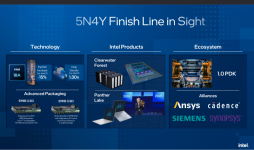The last question was what I was looking for:

Matthew Ramsay
Yes, I do. Thanks, John. I wanted to ask -- I think in some of the prepared script and maybe early in the Q&A, Pat, you kind of reiterated the $15 billion funnel for the Foundry business, and I know in the medium term, a lot of that is packaging, but I wanted to ask about the customers that you've engaged with on 18A and maybe early on 14A, how have you seen the charts of the programs that they're planning to bring into your foundry progress in the last few quarters. Are people still committed to ramping those things? Are they taking PDKs and maybe doing tape-ins? Are things moving forward? Have you seen any acceleration? Have you seen hesitation or maybe wait-and-see from those customers? I'm just trying to figure out how that stuff is progressing on 18A? Thanks.
Patrick Gelsinger
Yes. Let me just clarify, the $15 billion is lifetime deal value of committed deals, right? So this isn't a pipeline. This is committed business that we now have in place. So I just want to clarify that, Matt, because I think your question suggests that the pipeline. There's a lot more in the pipeline. This is $15 billion of committed deals. As you say, a lot of the near-term opportunity has been advanced packaging and we're seeing a significant expansion of that capability in terms of volume and technology. On 18A specifically, a lot of customers have been waiting for the PDK, right, and now that we released the PDK last month, the 1.0 PDK, we've seen a flurry of activity with the EDA, the IP vendors, and the end customers.
So I'd be optimistic that we have good indicators coming in that area in the future, but this was really the starting point for many of them to go from test chips to start looking at production chips coming based on the PDK that we've just released. So we remain very comfortable with our earlier comments in that area. I'd say, we do believe that we'll have further updates there, but as we've also indicated, customers are reluctant to put their name out there given the supply base and the traditional operation of the Foundry industry. Overall, things are looking on track for what we've said with a meaningful acceleration in packaging over the last quarter, more updates to come.
Matthew Ramsay
Yes, I do. Thanks, John. I wanted to ask -- I think in some of the prepared script and maybe early in the Q&A, Pat, you kind of reiterated the $15 billion funnel for the Foundry business, and I know in the medium term, a lot of that is packaging, but I wanted to ask about the customers that you've engaged with on 18A and maybe early on 14A, how have you seen the charts of the programs that they're planning to bring into your foundry progress in the last few quarters. Are people still committed to ramping those things? Are they taking PDKs and maybe doing tape-ins? Are things moving forward? Have you seen any acceleration? Have you seen hesitation or maybe wait-and-see from those customers? I'm just trying to figure out how that stuff is progressing on 18A? Thanks.
Patrick Gelsinger
Yes. Let me just clarify, the $15 billion is lifetime deal value of committed deals, right? So this isn't a pipeline. This is committed business that we now have in place. So I just want to clarify that, Matt, because I think your question suggests that the pipeline. There's a lot more in the pipeline. This is $15 billion of committed deals. As you say, a lot of the near-term opportunity has been advanced packaging and we're seeing a significant expansion of that capability in terms of volume and technology. On 18A specifically, a lot of customers have been waiting for the PDK, right, and now that we released the PDK last month, the 1.0 PDK, we've seen a flurry of activity with the EDA, the IP vendors, and the end customers.
So I'd be optimistic that we have good indicators coming in that area in the future, but this was really the starting point for many of them to go from test chips to start looking at production chips coming based on the PDK that we've just released. So we remain very comfortable with our earlier comments in that area. I'd say, we do believe that we'll have further updates there, but as we've also indicated, customers are reluctant to put their name out there given the supply base and the traditional operation of the Foundry industry. Overall, things are looking on track for what we've said with a meaningful acceleration in packaging over the last quarter, more updates to come.
Last edited:

